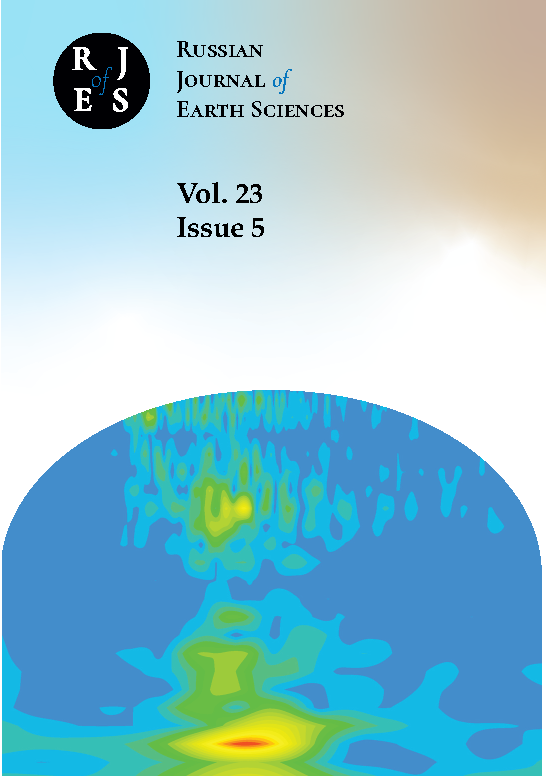Nizhny Novgorod, Nizhny Novgorod, Russian Federation
Russian Federation
Russian Federation
China
China
UDC 53
UDC 55
UDC 550.34
UDC 550.383
CSCSTI 37.01
CSCSTI 37.15
CSCSTI 37.25
CSCSTI 37.31
CSCSTI 38.01
CSCSTI 36.00
CSCSTI 37.00
CSCSTI 38.00
CSCSTI 39.00
CSCSTI 52.00
Russian Classification of Professions by Education 05.00.00
Russian Library and Bibliographic Classification 26
Russian Trade and Bibliographic Classification 63
BISAC SCI SCIENCE
At the small incidence angles, the dominant backscattering mechanism for sea waves is the quasi-specular backscattering mechanism. The power of the reflected signal depends on the distribution function of the slopes of large-scale waves (in comparison with radar wavelength) and on the effective reflection coefficient, which is introduced instead of the Fresnel coefficient. In this paper, we discussed a new method for calculating the effective reflection coefficient from the wave scatterometer SWIM data. For the first time, measurements are performed by a radar at different azimuth angles at small incidence angles. This makes it possible to measure the effective reflection coefficient. An original algorithm was developed for data processing and determination of the total mean square slopes of large-scale sea waves and the azimuth dependence of the backscattering radar cross section at zero incidence angle. In the result of subsequent processing, the azimuth dependence of the effective reflection coefficient is retrieved. SWIM data were used to evaluate the developed algorithm. Processing of the test data set confirmed the efficiency of the algorithm. The azimuth anisotropy coefficients for the mean square slopes of large-scale waves and the effective reflection coefficient are calculated
microwaves, small incidence angles, Fresnel coefficient, effective reflection coefficient
1. Bass, F. G., and I. M. Fuks (1979), Wave Scattering from Statistically Rough Surfaces, 528 pp., Elsevier, https://doi.org/10.1 016/c2013-0-05724-6.
2. Chen, P., G. Zheng, D. Hauser, and F. Xu (2018), Quasi-Gaussian probability density function of sea wave slopes from near nadir Ku-band radar observations, Remote Sensing of Environment, 217, 86-100, https://doi.org/10.1016/j.rse.2018.07.027. EDN: https://elibrary.ru/YHCFPF
3. Chu, X., Y. He, and G. Chen (2012), Asymmetry and Anisotropy of Microwave Backscatter at Low Incidence Angles, IEEE Transactions on Geoscience and Remote Sensing, 50(10), 4014-4024, https://doi.org/10.1109/tgrs.2012.2189010. EDN: https://elibrary.ru/RJPMXD
4. Freilich, M. H., and B. A. Vanhoff (2003), The Relationship between Winds, Surface Roughness, and Radar Backscatter at Low Incidence Angles from TRMM Precipitation Radar Measurements, Journal of Atmospheric and Oceanic Technology, 20(4), 549-562, https://doi.org/10.1175/1520-0426(2003)20%3C549:TRBWSR%3E2.0.CO;2.
5. Hauser, D., G. Caudal, S. Guimbard, and A. A. Mouche (2008), A study of the slope probability density function of the ocean waves from radar observations, Journal of Geophysical Research, 113(C2), https://doi.org/10.1029/2007jc004264. EDN: https://elibrary.ru/TQDVDV
6. Hauser, D., C. Tison, T. Amiot, L. Delaye, N. Corcoral, and P. Castillan (2017), SWIM: The First Spaceborne Wave Scatterometer, IEEE Transactions on Geoscience and Remote Sensing, 55(5), 3000-3014, https://doi.org/10.1109/tgrs.2017.2658672
7. Hauser, D., C. Tourain, L. Hermozo, D. Alraddawi, L. Aouf, B. Chapron, A. Dalphinet, L. Delaye, M. Dalila, E. Dormy, F. Gouillon, V. Gressani, A. Grouazel, G. Guitton, R. Husson, A. Mironov, A. Mouche, A. Ollivier, L. Oruba, F. Piras, R. R. Suquet, P. Schippers, C. Tison, and N. Tran (2021), New Observations From the SWIM Radar On-Board CFOSAT: Instrument Validation and Ocean Wave Measurement Assessment, IEEE Transactions on Geoscience and Remote Sensing, 59(1), 5-26, https://doi.org/10.1109/tgrs.2020.2994372.
8. Karaev, V. Y., M. A. Panfilova, M. S. Ryabkova, Y. A. Titchenko, E. M. Meshkov, and X. Li (2021), Retrieval of the two-dimensional slope field by the SWIM spectrometer of the CFOSAT satellite: discussion of the algorithm, Russian Journal of Earth Sciences, 21(6), 1-9, https://doi.org/10.2205/2021es000784.
9. Li, X., V. Karaev, M. Panfilova, B. Liu, Z. Wang, Y. Xu, J. Liu, and Y. He (2022a), Measurements of Total Sea Surface Mean Square Slope Field Based on SWIM Data, IEEE Transactions on Geoscience and Remote Sensing, 60, 1-9, https: //doi.org/10.1109/tgrs.2022.3174392. EDN: https://elibrary.ru/MHKQAA
10. Li, X., W. Lin, B. Liu, Z. Wang, B. Zhang, and Y. He (2022b), Sea Surface Wind Retrieval Using the Combined Scatterometer and Altimeter Backscatter Measurements of the HY-2B Satellite, IEEE Transactions on Geoscience and Remote Sensing, 60, 1-12, https://doi.org/10.1109/tgrs.2021.3065663.
11. Lin, C.-C., M. Betto, M. B. Rivas, A. Stoffelen, and J. de Kloe (2012), EPS-SG Windscatterometer Concept Tradeoffs and Wind Retrieval Performance Assessment, IEEE Transactions on Geoscience and Remote Sensing, 50(7), 2458-2472, https://doi.org/10.1109/tgrs.2011.2180393.
12. Masuko, H., K. Okamoto, M. Shimada, and S. Niwa (1986), Measurement of microwave backscattering signatures of the ocean surface using X-band and Ka-band airborne scatterometers, Journal of Geophysical Research, 91(C11), 13,065, https://doi.org/10.1029/jc091ic11p13065.
13. Panfilova, M., V. Karaev, L. Mitnik, Y. Titchenko, M. Ryabkova, and E. Meshkov (2020), Advanced View at the Ocean Surface, Journal of Geophysical Research: Oceans, 125(11), https://doi.org/10.1029/2020jc016531. EDN: https://elibrary.ru/BMEVAI
14. Valenzuela, G. R. (1978), Theories for the interaction of electromagnetic and oceanic waves - A review, Boundary-Layer Meteorology, 13(1-4), 61-85, https://doi.org/10.1007/bf00913863. EDN: https://elibrary.ru/KCMJOP
















